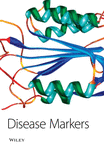ɛ3ɛ4 Genotype as Risk Factor of Myocardial Infarction in Middle-Aged People in Spain
Abstract
Apolipoprotein E (apoE) plays an important role in lipid metabolism. Its ɛ4 allele has been consistently associated with lipoprotein disorders but its connection to myocardial infarction (MI) is controversial. Because ɛ4 frequency decreases with age we thought that the contradictory results in different studies could be due to the wide age range of the subjects included. To test our hypothesis, ApoE genotyping was performed in 474 MI cases and an analysis was performed by percentiles of age. The frequencies of ɛ3ɛ4 genotype and ɛ4 allele in the MI group as a whole (subjects aged 31 to 92) were not significantly different from those in our area general population. However, significant differences were observed when comparing by group of age. The frequencies decreased as age increased. The ɛ3ɛ4 and ɛ4 frequencies were significantly higher in MI subjects aged 31 to 56 than in subjects over 74. The ɛ3ɛ4 genotype prevalence in an age and sex matched control group of subjects aged 31 to 56 was significantly lower than in the 31–56 year-old MI group. In conclusion, our data shows different ɛ3ɛ4 and ɛ4 frequencies depending on the age range of the subjects with MI, being significantly higher in the middle-aged group. This finding may help explain the discrepancies between studies analyzing association between apoE genotype and MI, and emphasizes the idea of considering apoE genotype for prevention at early age.




